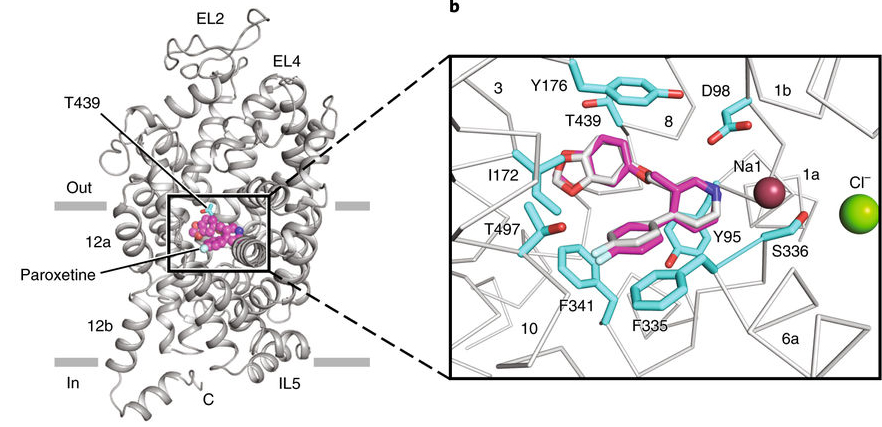
The original Oregon Health & Science University press release by Erik Robinson can be read here.
New molecular research carried out at two U.S. Department of Energy national user facilities including the Advanced Photon Source (APS) shows how chemically diverse drugs used to treat depression and anxiety disorders interact with the protein that transports serotonin in the brain. The discovery by researchers at the Oregon Health & Science University (OHSU) Vollum Institute could open the way for the development of additional forms of antidepressants collectively known as selective serotonin reuptake inhibitors, or SSRIs.
The study was published in the journal Nature Structural & Molecular Biology.
“This work tells a great deal about how clinically relevant antidepressants work,” said article senior author Eric Gouaux, senior scientist in the OHSU Vollum Institute.
Serotonin is a chemical messenger that acts as a neurotransmitter, carrying signals between neurons. Serotonin signaling controls many aspects of human behavior, including memory, learning, sleep, hunger, pain, sexual function and mood. SSRIs are chemical compounds that block the reabsorption (or reuptake) of serotonin into nerve cells. This has the effect of increasing the level of serotonin in synapses, allowing for prolonged serotonin signaling in patients suffering from anxiety disorders or depression.
The six most commonly prescribed SSRIs approved by the Food and Drug Administration for clinical treatment of depression can have varying levels of success and side effects depending on the patient. The OHSU researchers found that while these SSRI molecules are chemically quite different, they all bind to a central site in the serotonin transporter, locking the transporter in a state that blocks serotonin binding and reabsorption into nerve cells.
“We wondered how these drugs, which are quite different, managed to accomplish a similar action on the transporter,” said lead author Jonathan Coleman, a researcher in the Gouaux Lab.
Coleman and colleagues used x-ray crystallography techniques at the Northeastern Collaborative Access Team x-ray beamline 24-ID-E at the Argonne National Laboratory APS and at the Advanced Light Source (Lawrence Berkeley National Laboratory, beamline 5.0.2) to deduce the atomic structure of the serotonin transporter as it binds to each drug. This involved purifying the transporter-drug complexes and forming ordered arrays of protein crystals that could be used to map the position of the drugs. In discovering the atomic structure of the different molecules – and how they bind to the serotonin transporter – the study provides a pathway for the development of additional SSRIs to treat anxiety disorders while potentially limiting side effects such as sexual dysfunction, insomnia, nausea, headaches and diarrhea.
“We anticipate these studies should provide a blueprint for the development of new therapeutic agents for the treatment of depression and anxiety disorders,” the authors concluded.
See: Jonathan A. Coleman and Eric Gouaux*, “Structural basis for recognition of diverse antidepressants by the human serotonin transporter,” Nat. Struct. Mol. Biol., published online 29 January 2018. DOI: 10.1038/s41594-018-0026-8
Author affiliation: Oregon Health & Science University
Correspondence: *[email protected]
The authors acknowledge the staff of the Northeastern Collaborative Access Team at the Advanced Photon Source, and the Berkeley Center for Structural Biology at the Advanced Light Source for assistance with data collection. J.A.C. is supported by a Banting postdoctoral fellowship from the Canadian Institutes of Health Research. We are particularly grateful to B. LaCroute and J. LaCroute for their generous support, as well as for funding from the National Institutes of Health (NIH) (5R37MH070039) to E.G. E.G. is supported as an Investigator of the Howard Hughes Medical Institute. This work is based upon research conducted at the Northeastern Collaborative Access Team beamlines, which are funded by the National Institute of General Medical Sciences from the National Institutes of Health (P41 GM103403). The Eiger 16M detector on 24-ID-E beam line is funded by a NIH-ORIP HEI grant (S10OD021527). This research used resources of the Advanced Photon Source, a U.S. DOE Office of Science User Facility operated for the DOE Office of Science by Argonne National Laboratory, supported by Contract No. DE-AC02- 06CH11357.
Argonne National Laboratory seeks solutions to pressing national problems in science and technology. The nation's first national laboratory, Argonne conducts leading-edge basic and applied scientific research in virtually every scientific discipline. Argonne researchers work closely with researchers from hundreds of companies, universities, and federal, state and municipal agencies to help them solve their specific problems, advance America's scientific leadership and prepare the nation for a better future. With employees from more than 60 nations, Argonne is managed by UChicago Argonne, LLC for the U.S. Department of Energy's Office of Science.
The U.S. Department of Energy's Office of Science is the single largest supporter of basic research in the physical sciences in the United States and is working to address some of the most pressing challenges of our time. For more information, visit the Office of Science website.
